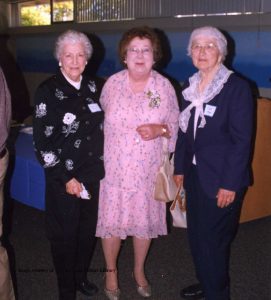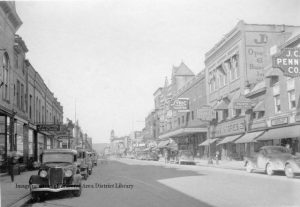
Excerpts from interview with Clare (Clara) Moon (b. 1918) on July the 22, 2003, at her home on Old Mission Peninsula; edited by Nancy Bordine, Vice President of the Women’s History Project of Northwest Michigan.
I was born in my parents’ home; likewise, all my siblings were born in the same place in East Bay Township on Garfield Avenue. At that time, they considered it to be seven miles from Traverse City, they being Traverse City State Bank.
Most farmers had a billboard out in front which stated their name and the amount of miles from the Traverse City State Bank. There was a blank space in case you had something for sale. In our case, my parents usually had raspberries, sweet corn or eggs. That was posted on a post on the roadside. My parents left theirs up for a good many years, even while I was in high school, which was in the thirties. I suppose they took it down because they didn’t have raspberries and sweet corn for sale. I haven’t noticed any of those signs for years now.
My paternal grandpa lived just up the road about one-eighth of a mile. In 1873, he and his wife, Johanna, came to this country. He had been in the army in Germany, and didn’t want his sons to be subject to army life.
They first settled in Pittsburgh. In 1875, they heard about how the railroads were opening up this Northern Michigan area. With the forests removed, they were encouraging people to come up and farm. The land was very, very reasonable and that was their purpose in coming. They came here and bought a hundred acres of land from the railroad, a good share of it was cleared and ready to be farmed.
My maternal grandfather was the second son of the family. The first son got the little bit of land that the family owned. At age sixteen, my grandfather managed to get work on a ship. The ship had neared the Ireland coast off the Straight of Dover when it caught fire. They were rescued by a cattle boat that was going to Quebec.
He made it to Quebec, then the Upper Peninsula, where he married. They came to Greilickville on West Bay to manage a boarding house for the lumbermen who worked at the Greilick Mill. They lived right smack on the corner of Cherry Bend and M-22, where a lovely church stands now. When my mother was seven, the family moved out to the farm in Blair Township where I was born.
One thing that played a good part in our social life while we were growing up in the country was the Grange. The Grange was a farm organization. It held the neighbors together for a common cause. There were always programs to improve the home or your farming. There would be speakers coming from the State Grange occasionally.
When a Grange leader from Lansing came to discuss an issue, Mother and Dad always provided room and board for him. It was unheard of for out-of-towners to stay in town or at motels.
The Grange Hall was a wonderful place for social activity, such as dancing, card parties, box socials and reunions. The dances at the Hall were well attended and lots of fun. Music was local from the neighborhood, piano playing by volunteers, usually my sisters, and violin and banjo from men and women who lived down the river on Keystone Road. Square-dancer callers were usually my dad, my uncle, or Frank Rusch. A bountiful lunch was served at 11 pm.

I went to the one-room school called the Hanie School on land donated by the Hanie Family. It was a typical one-room school with a wood shed. There was a pump outside and a common pail for drinking water and a common dipper.
When you come in the school there was a little entryway where you hung your coat and boots and whatnot, then the classroom itself, and in the front was the teacher’s desk and the recitation benches in front of the teacher’s desk. There were four rows of desks of various sizes. The eighth graders, of course, had the biggest desks.
You went to school with everybody you knew real well. The farmers didn’t change, they’d been around there for two and three generations; you knew everyone.
We had lots of snow in those days. We’d sled down hills during recess because we had a nice hill. Nobody had skis, but we had homemade sleds. Mr. Frank Rusch, a neighbor of ours, was a carpenter who made wonderful sleds. So the Rusch kids had better sleds than anybody else, but they were generous and we all used them.
I went to the country school through the eighth grade, and then I went on to the high school. I’m the only one from my class of three that went on to high school. Even though the district paid for the tuition, transportation was the problem. It was pre-buses in those days. My older brother could drive a car. We’d had a very good raspberry crop that year, so we were able to buy a Ford coup. Not only did the two of us ride in the car, but we picked up a neighbor boy who lived nearer to town.
You could live in town with somebody or board. I had several girlfriends who earned their keep by boarding, working, and taking care of the family’s children.

I was working at the Penney’s Store, which is now the Horizon bookstore, that first summer after I graduated. One day these two guys came in and they kept staring at me. One was my future husband, looking over the field.
My husband’s Grandpa Brosche came to this country because his brother had a meat market in Traverse City. The brother had a lot of land for raising Angus beef. In fact, most of the land that he owned was right across from the high school where Orchard Heights sub-division is now. His frontage on East Bay was considered worthless because you couldn’t raise anything there; it was full of stones and poison ivy.
Unfortunately, my husband and I moved to the Detroit area to provide a livelihood. We lived for thirty-two years in Ferndale. Every summer we came back here. My husband would travel back and forth to Ferndale. We bunked in with anybody that would put up with us; namely, my parents. I would help on the farm, hauling sweet corn to town. My husband got us a truck to run around in so that we’d have wheels.
Our boys worked in the cherrypicking industry. They’d pick cherries down here at McManus orchards until it was beneath their dignity to pick cherries. Then they got summer jobs in the Detroit area that were a little more lucrative.
As a kid, I liked to draw. My parents had two acres of raspberries, wonderful crops the raspberries. I’d look across the fields when I was bored and see the uncut hay with the wind blowing. There would be that nice wavy feeling, like ocean waves. I was just enthralled by that.
Later in life, when my son went off to school, he said to me, “Now Ma, you get your books and go with me.” I found there were courses available here and there in Royal Oak. Later on there were courses offered through Wayne University, and the instructors came out to Royal Oak. So I took advantage of lessons in design and composition.
A friend of mine invited me to join the Palette and Brush Club of Detroit. We had speakers from Ann Arbor, U of M, and Wayne, just wonderful speakers.
The Detroit Society of Arts and Crafts would speak and then you could take your work and have it juried in front of everybody. I really liked that.
When I saw the work of Louis King, I said, “Oh, I’d love to get a hold of him!” Louis said he would teach a class for us, provided I came up with at least nine people to make it worthwhile for him. He came to our little studio on Nine Mile Road.
I usually painted still lifes. When I’d come up in the summers, I’d paint all over the country here. I was sitting in a ditch one day on Bunker Hill, looking up at this farm setting of a barn, a house, and outer buildings when Mr. Larry Hoxsie, the mailman, went by. The next day I was painting the church over on Bates Road, which was also part of Mr. Hoxsie’s route. He stopped and said, “I want to see that painting when you’re done.” At that time his wife was baking pies to sell on the roadside. She said, “I’ll just bake a few more pies.” I saw her not too long ago, and she said they still had that painting.
I taught some lessons and courses down in Traverse at the Art Center. That group of about nine of us stayed together for fifteen years. We had wonderful shows at the State of the Art. Every year for about fifteen years we’d put on something. We used to come out here and sit in the woods, or paint alongside the road. We’d have a little lunch together. It was a very, very easy group to be with. I do not have any degree in art. I just like to do it and try to help others. I stuck with it over the years, and I intend to stick with it!
Our children really have a great amount of interest in our place here. I hope it continues for a long time because now their children’s children feel they have a stake in the place. Provided they can keep up with the tax problem. It isn’t a problem; it’s just something that sometimes is hard for them. You never know who might dangle a couple million under their nose and they’d give up this place for money. When our grandkids were real young, and we’d be out swimming, I’d say, “Now, what aren’t you suppose to do?” The grandkids would chime in with me, “Don’t sell the property!” It’s just wonderful that they all want to come back here.
At our family reunion here I told them, “There is the wealth of knowledge and the wealth of friends, the wealth of health, and the wealth of faith. To me the wealth of family is the most important.”


Many years ago when I was just a kid my mother Agnes Joey Tzay and Clara Moon would throw their easels ,paint supplies and me into the old Ford Fairlane station wagon’s and wander aimlessly throughout the Traverse bay area to paint pictures of the local family farm houses ,barns and landscapes of an era now gone by . There’s the old lilac house, white pine house , the Sawyer farm and many more. We’d also spend wonderful summer afternoons at a home Ms. Moon and her family had on the Old Mission Peninsula on the east bay side. These two ladies inspired me to paint which I continue to do today. Thanks for the memories! Chet
That was so precious. Thank you for sharing.
Jill